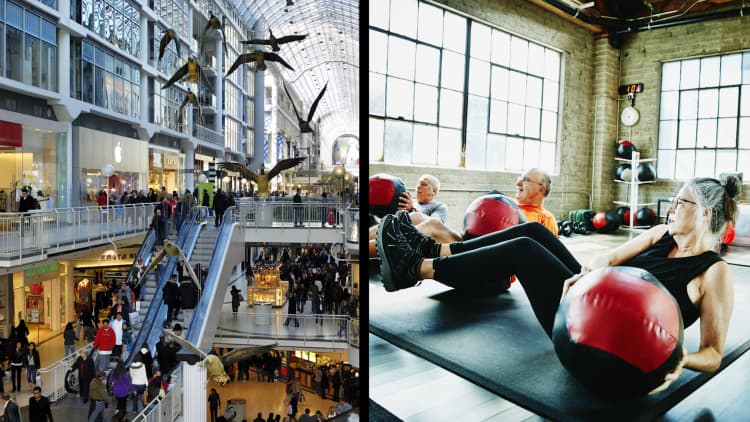
The fitness industry is booming. The mall business is not. Put a gym in a mall, and boom, you suddenly have a busier mall. Anything to get foot traffic, even if they're sweaty feet.
It works for Monday Isa, who works out at the Planet Fitness in the Mall at Prince Georges in Hyattsville, Maryland. He's not a fan of malls, at least not since he was a kid.
"In my younger days was a place to hang out, movies, now being older it's just, what do I need? Can I get in and out quickly? Otherwise, I'll purchase online," he laughed.
Once he's in the mall, he does stop by other stores to get what he needs on his way out. So does Meredith Anderson. Sometimes she gets a little something extra.
"I do find myself sometimes spontaneously going to the mall after I work out because it's convenient, and to be honest, sometimes I'll go to the mall as a little treat if I have a really good workout," admitted Anderson.
It's just what landlords want to hear. Back before the internet, when malls were full, landlords didn't want to waste their space on anything but retail. They also didn't want sweaty shoppers in their stores. That has all changed.
The number of gym leases in malls has doubled in the last five years, according to commercial real estate information firm CoStar.
Joe Coradino, CEO of Philadelphia-based PREIT, which owns 22 million square feet of retail space in malls across the Northeast and Mid-Atlantic, is actively recruiting fitness companies to fill his malls. Planet Fitness, Orangetheory – big names that draw big numbers back into the mall space.
"People are not just taking up time at the gym here, they're going to the gym, they're cross-shopping, they're buying clothes, they're dining out, they're doing things that are more than just working out," said Coradino.
They're working out and then walking into both retail and restaurants. All part of the mall metamorphosis from straight retail to full-on entertainment centers. Apparel used to make up 70 percent of the mall space, according to Coradino. Now it is about 40 percent.
Online shopping is causing the drop in retail traffic at malls, while fitness is growing fast, with both discount gyms and so-called boutique studios, which command higher prices. Mall gyms can take up a large footprint or a small studio space.
More than 57 million people belong to a health club of some type, according to the most recent survey by the International Health, Racquet & Sportsclub Association. Memberships are up 26 percent since 2009.
There is no specific data yet showing whether gyms do in fact drive more traffic to other parts of the mall, but Coradino said he is definitely seeing it anecdotally.
"The test for us is, we like it enough that we're doing more of these. We're not just doing one or two. We're about to open one in a Washington suburb, and we've got three or four in negotiations right now," he said.
About half of the fitness companies leasing space in malls are in so-called B malls, not the fanciest or most expensive properties. That is changing, however, as boutique fitness evolves. Higher-end specialty brands offering Pilates, barre and cycling, are popping up in higher-end malls.
PREIT is about to open a Onelife Fitness location just outside Washington, D.C., that will have both indoor and outdoor swimming pools as part of the mall. Coradino said it choose the fitness brand based on the type of market — urban or suburban — and the type of neighborhood. Some gyms have monthly fees as low as $10, while others can be $40 per class.
"I think it really depends on the demographic profile of the property," said Coradino.
And while the gym brings traffic into the mall, the mall can also help the gym drum up business.
"It's a great partnership. The mall can feed off the gym and the gym can feed off the mall," said Craig Mimms, acting regional manager at the Planet Fitness in Hyattsville.
Mimms also points to the vast amount of free parking that malls offer as another selling point to the gym. Convenience is clearly key for both shoppers and exercisers.
"Sometimes when I need to buy anything, I wait until I come here because it's easier for me to come here after the gym," said Colin Ilolo. "I walk inside the mall and buy whatever I want to buy."


